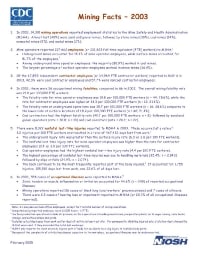Mining Publication: Mining Facts - 2003
Original creation date: February 2005
Authors: National Institute for Occupational Safety and Health
NIOSHTIC2 Number: 20025908
U.S. Department of Health and Human Services, Public Health Service, Centers for Disease Control and Prevention, National Institute for Occupational Safety and Health, DHHS (NIOSH) Publication No. 2005-113, 2005 Feb; :1
In 2003, 14,391 mining operations reported employment statistics to the Mine Safety and Health Administration (MSHA). Almost half (49%) were sand and gravel mines, followed by stone mines (30%), coal mines (14%), nonmetal mines (5%), and metal mines (2%). Mine operators reported 217,662 employees (or 221,923 full-time equivalent (FTE) workers) to MSHA. Of the 67,855 independent contractor employees (or 34,969 FTE contractor workers) reported to MSHA in 2003, 42.3% were coal contractor employees and 57.7% were noncoal contractor employees. In 2003, there were 56 occupational mining fatalities, compared to 66 in 2002. The overall mining fatality rate was 21.8 per 100,000 FTE workers. There were 8,322 nonfatal lost-time injuries reported to MSHA in 2003. These occurred at a rate of 3.2 injuries per 100 FTE workers and resulted in a total of 467,432 days lost from work. In 2003, 558 cases of occupational illnesses were reported to MSHA.

NIOSHTIC2 Number: 20025908
U.S. Department of Health and Human Services, Public Health Service, Centers for Disease Control and Prevention, National Institute for Occupational Safety and Health, DHHS (NIOSH) Publication No. 2005-113, 2005 Feb; :1
- Coal and metal/nonmetal mining facts - 2008
- Coal and Metal/Nonmetal Mining Facts - 2008 (HTML)
- Coal Contractor Mining Facts - 2001
- Coal Contractor Mining Facts - 2002
- Coal Contractor Mining Facts - 2003
- Coal Contractor Mining Facts - 2004
- Coal Contractor Mining Facts - 2005
- Coal Contractor Mining Facts - 2006
- Mining Fact Sheets
- Rib Falls: A Major Ground Control Issue